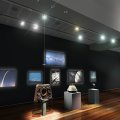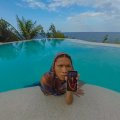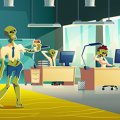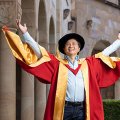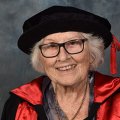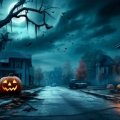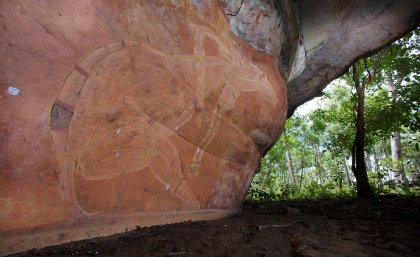
A remarkable exhibition of Indigenous rock art from the Western Arnhem Land Plateau will open tomorrow at The University of Queensland’s Anthropology Museum.
The photographic exhibition, Fragile First Impressions, shows artists' interpretations of their encounters with buffalo hunters and miners at a northern frontier in the mid-late Nineteenth Century.
Warddeken Land Management Director Terah Guymala said the paintings depicted scenes that went along with a story.
“Now we have only the pictures,” Mr Guymala said.
“The voices are gone and understanding the stories behind them is a puzzle — like detective work,” he said.
The exhibition is curated by Peter Cooke for Warddeken Land Management with photographs by David Hancock.
Mr Cooke said Aboriginal artists encountering horses for the first time on the Western Arnhem Land Plateau drew horses that resembled kangaroos.
“This parallels the experience of early colonial artists whose Australian fauna was similarly influenced by mental templates for European fauna,” he said.
Preparing the exhibition involved connecting Aboriginal oral histories with written reports from non-Aboriginal sources and material from an archaeological site on the Alligator River floodplains.
In one case an extremely accurate connection has been made.
When the surveyor David Lindsay and his party crossed the Arnhem Plateau in 1883, he recorded how they spelled their horses for four days and cast away a fishing net and saddle bags.
Just 10 years ago a site with clear depictions of the cast off material and Europeans, horses and guns was found a few kilometres from David Lindsay’s camp.
“It’s very rare to be able to state confidently exactly when a rock art image was painted — in this case we can say that these images of Lindsay were painted in October 1883,” Mr Cooke said.
Anthropology Museum director Dr Diana Young said the exhibition was an archive of threatened Aboriginal reportage.
“Among the many local Indigenous histories of frontier experience, those portrayed in this exhibition are about the desire for novel things and new experiences,” she said.
“These complex over-layered images reveal man-sized chickens, guns, policemen and buffalo among other things.”
The exhibition is complemented by objects from the UQ collection demonstrating the incorporation of novel materials into Aboriginal social.
Terah Guymala and Peter Cooke are both in Brisbane for the exhibition opening on Friday.
Media: Gillian Ievers g.ievers@uq.edu.au, 07 3346 1633 or Dr Diana Young djbyoung@uq.edu.au, 07 33651210

